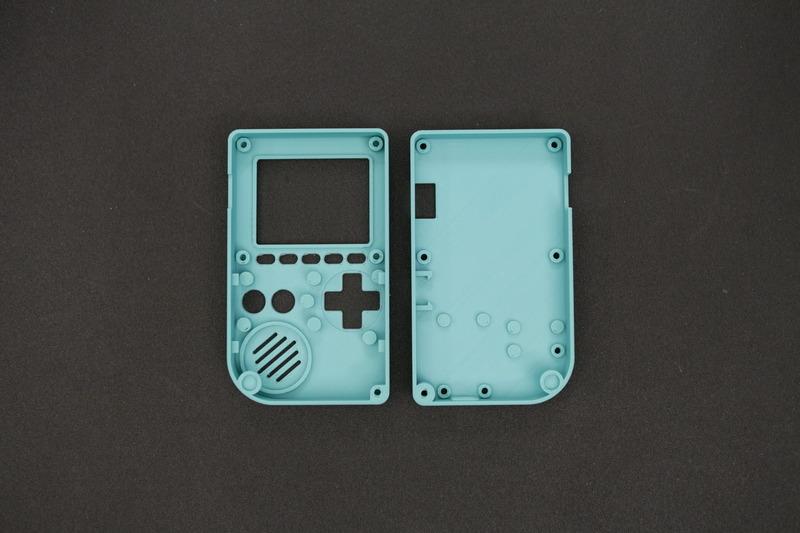
Hillary Rodham Clinton playing a Nintendo Game Boy on the flight from Austin en route to Washington in 1993
The Nintendo Game Boy was a handheld video game device that exploded onto the market in 1989 (selling out of its initial shipment of one million devices to the US in only a couple of weeks). It was discontinued in 2003 but its appeal is still strong among 8-bit gaming enthusiasts. The PiGRRL is a handheld gaming device strongly reminiscent of the Game Boy, but its design is more homage than rip off. Of course, it doesn’t hurt that its name finally acknowledges that girls wanna play games too…
With the introduction of the Pocket PiGRRL, you can get all of the gaming punch in a much smaller package. A complete tutorial from the Ruiz Brothers walking you through all of the steps necessary to create the device contains signature Adafruit humor and is billed as “super fun”–a designation that makes it hard to resist. Be forewarned, however, if you have never done a 3D print and DIY electronics project before, this might not be the easiest place to start. Although the thing is just so darned cute that it can be the motivation you may have needed to engage in a first project. Even the warning comes in the bubbly and effusive tone that has come to be associated with Adafruit:
“So, if this is your first DIY electronics + 3D printing project, you might want to try a simpler project with less wiring and soldering. That said, you shouldn’t feel discouraged to take on the project.”
 The system is built around a Raspberry Pi 1 Model A+, which replaced the original Model A in November 2014 and brings with it a smaller size and lower power consumption. The screen for the pocket PiGRRL is an adorable little 2.4” display with 320×240 16-bit color available for just under $35. The list of parts is not long, unfortunately, as of the time I am writing this, a few of the links click through to a 404 page and so you’re on your own to search for them – but frankly if that’s the worst thing that happens, then life is pretty good.
The system is built around a Raspberry Pi 1 Model A+, which replaced the original Model A in November 2014 and brings with it a smaller size and lower power consumption. The screen for the pocket PiGRRL is an adorable little 2.4” display with 320×240 16-bit color available for just under $35. The list of parts is not long, unfortunately, as of the time I am writing this, a few of the links click through to a 404 page and so you’re on your own to search for them – but frankly if that’s the worst thing that happens, then life is pretty good.
Let’s assume complete success in the wiring and circuitry and get to the part that’s most interesting to us: the 3D printed case. Each half is printed in a single run and is optimized to print centered on any printer with a minimum bed size of 120 x 70 mm. The print time is estimated at an hour for the top half and just slightly longer for the bottom. In addition to the top and bottom of the case, STL files are provided for the buttons and pads, each printing in less than 15 minutes. The files are available at Thingiverse.
The Ruiz Brothers test printed the pieces in PLA, ABS, BambooFill, and CopperFill and found them all to be satisfactory materials. The buttons should be printed in a TPE flexible filament to prevent them from mashing all the buttons in a location down at the same time. So if you’ve been looking for something to print with NinjaFlex, this might be a good time to get it out.
The Ruiz Brothers also offer great advice on spot-checking the printing process itself so that you can be alerted to any foundational problems that would result in a deformed or inaccurate build before you’ve finished the whole print. All in all, this tutorial has the same combination of honesty, specificity and humor we’ve come to expect from Adafruit. And you can share your version of it by posting a picture on any social channel with the hashtags #PiGRRL #Adafruit.
Let us know if you’ve made your own project in the Pocket PiGRRL forum thread at 3DPB.com. Check out the video of the project below.
Subscribe to Our Email Newsletter
Stay up-to-date on all the latest news from the 3D printing industry and receive information and offers from third party vendors.
You May Also Like
3D Printing Financials: Fathom Struggles in Financial Quicksand During Critical Transition
Facing a year of key transitions and financial pressures, Fathom (Nasdaq: FTHM) has filed its annual report for 2023 with the U.S. Securities and Exchange Commission (SEC). The document outlines...
Latest Earnings Overview for Australian 3D Printing Firms Titomic and AML3D
Australian 3D printing manufacturing firms Titomic (ASX: TTT) and AML3D (ASX: AL3) reported their financial results for the period from July to December 2023, marking the first half of their...
3D Printing Webinar and Event Roundup: April 7, 2024
Webinars and events in the 3D printing industry are picking back up this week! Sea-Air-Space is coming to Maryland, and SAE International is sponsoring a 3D Systems webinar about 3D...
3D Printing Financials: Unpacking Farsoon and BLT’s 2023 Performance
In the Chinese 3D printing industry, two companies, Farsoon (SHA: 688433) and Bright Laser Technologies, or BLT (SHA: 688333), have recently unveiled their full-year earnings for 2023. Farsoon reported increases...

































